Impact of Cultural Diversity on Woolworths Performance Report
VerifiedAdded on 2020/05/28
|6
|977
|46
Report
AI Summary
This report investigates the impact of cultural diversity on organizational performance, specifically focusing on Woolworths Superstore in Melbourne CBD. The introduction highlights the changing workforce landscape and the importance of managing diversity effectively to enhance organizational performance. The problem statement identifies the challenges managers face in analyzing diversity factors and the inconsistent results of diversity on organizational performance. The research aims to examine the impact of cultural diversity on Woolworths, explore both positive and negative impacts, determine effective diversity management strategies, and recommend actions for management. The methodology includes descriptive research using both qualitative and quantitative data collection methods, such as surveys and analysis of journal articles. The report aims to provide insights into employee perceptions of diversity and offer recommendations for improving diversity management within Woolworths.
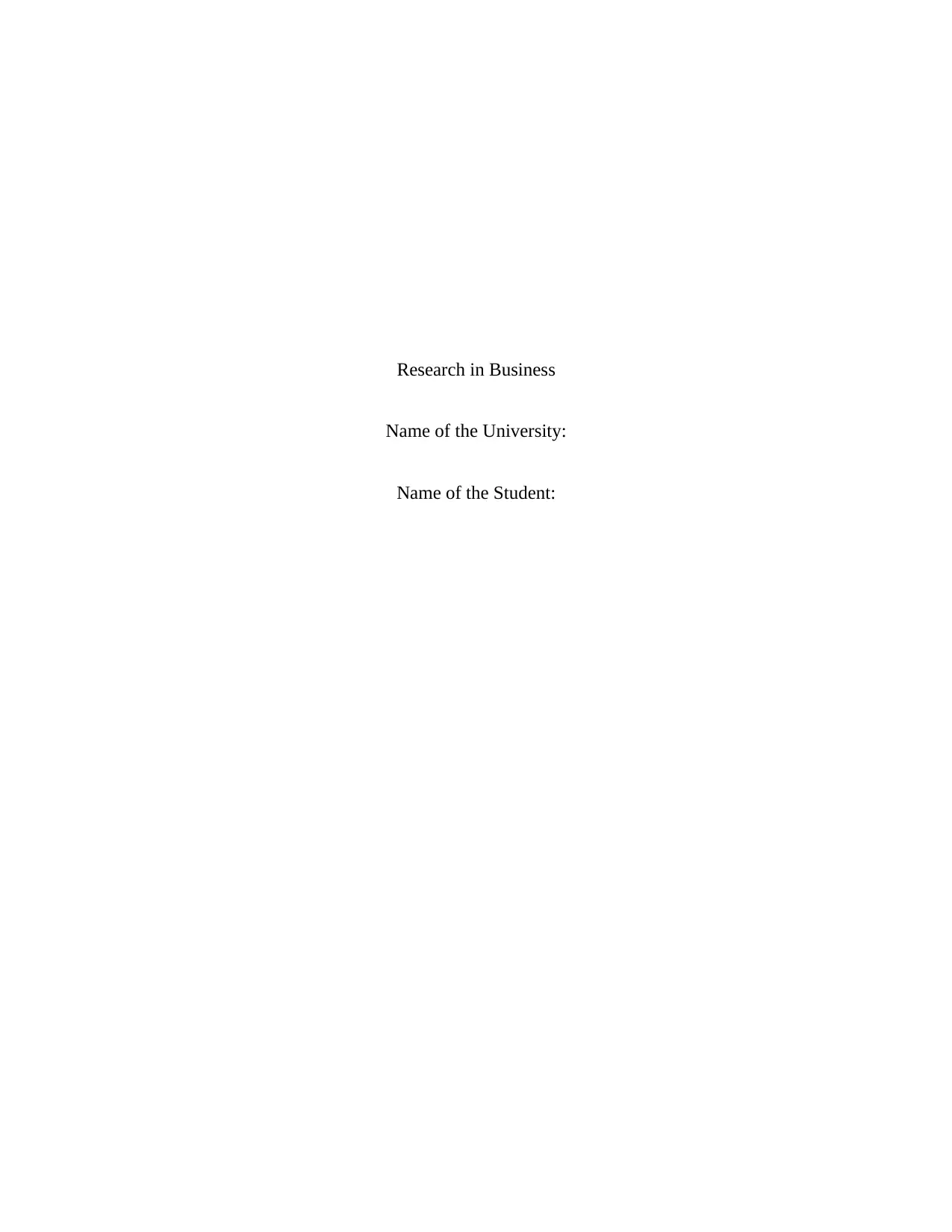
Research in Business
Name of the University:
Name of the Student:
Name of the University:
Name of the Student:
Paraphrase This Document
Need a fresh take? Get an instant paraphrase of this document with our AI Paraphraser
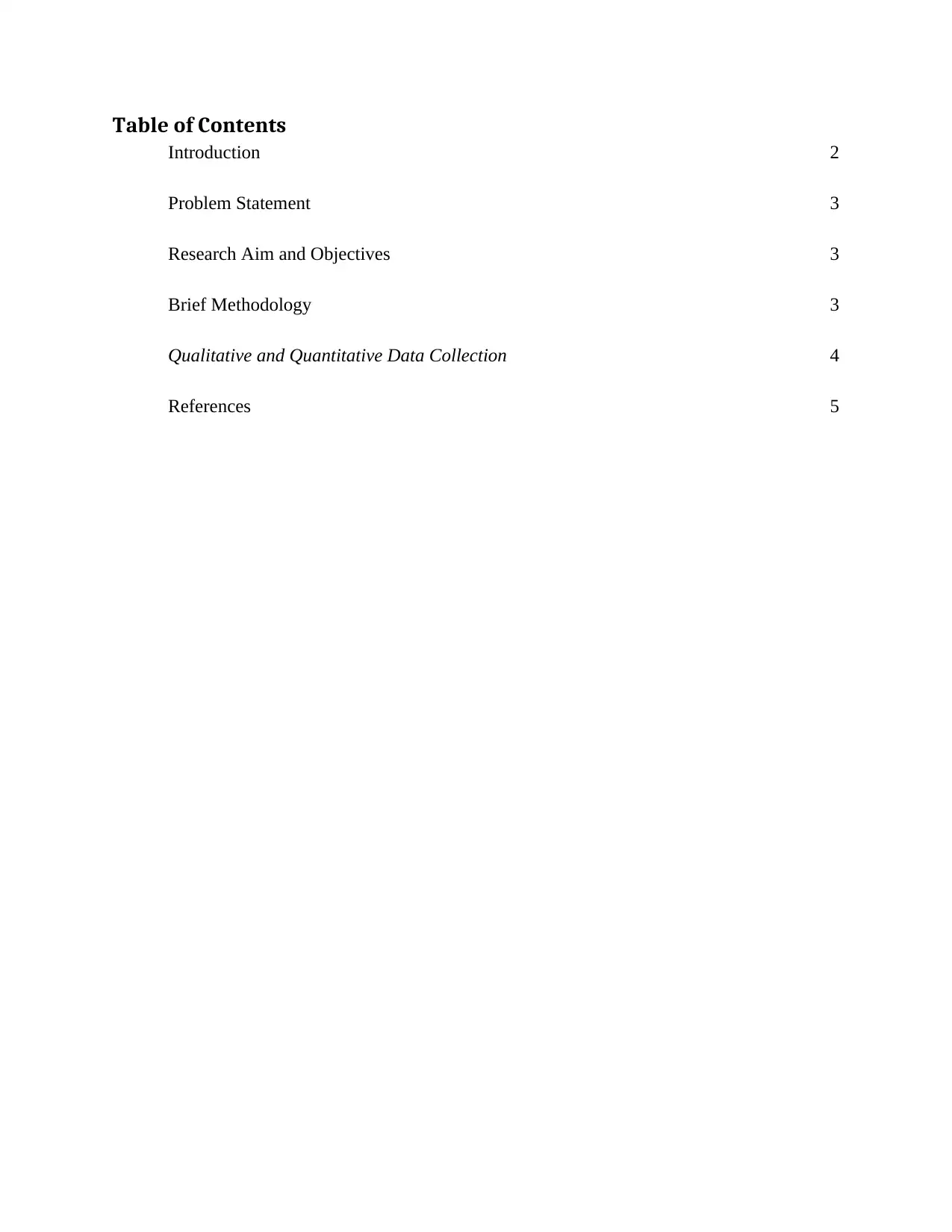
Table of Contents
Introduction 2
Problem Statement 3
Research Aim and Objectives 3
Brief Methodology 3
Qualitative and Quantitative Data Collection 4
References 5
Introduction 2
Problem Statement 3
Research Aim and Objectives 3
Brief Methodology 3
Qualitative and Quantitative Data Collection 4
References 5
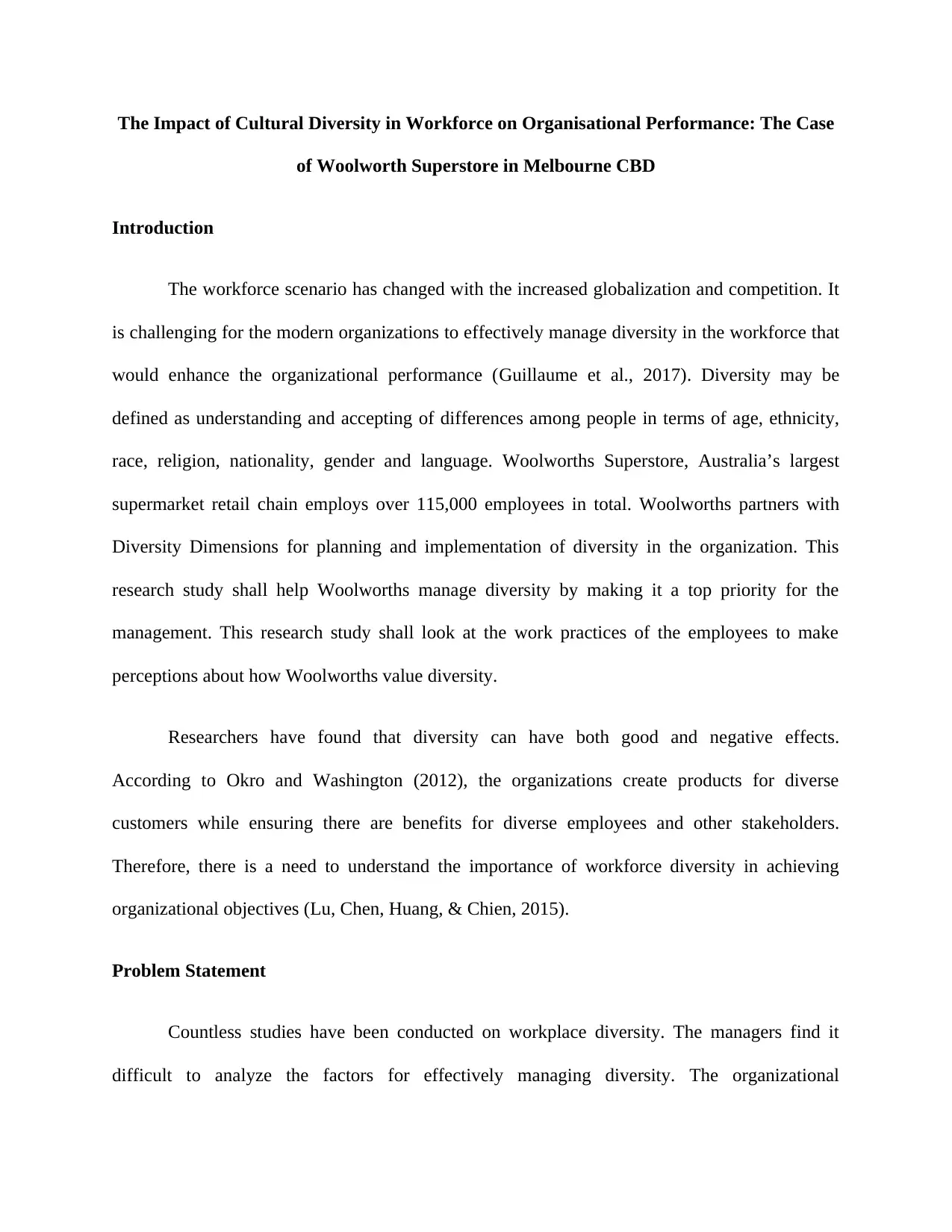
The Impact of Cultural Diversity in Workforce on Organisational Performance: The Case
of Woolworth Superstore in Melbourne CBD
Introduction
The workforce scenario has changed with the increased globalization and competition. It
is challenging for the modern organizations to effectively manage diversity in the workforce that
would enhance the organizational performance (Guillaume et al., 2017). Diversity may be
defined as understanding and accepting of differences among people in terms of age, ethnicity,
race, religion, nationality, gender and language. Woolworths Superstore, Australia’s largest
supermarket retail chain employs over 115,000 employees in total. Woolworths partners with
Diversity Dimensions for planning and implementation of diversity in the organization. This
research study shall help Woolworths manage diversity by making it a top priority for the
management. This research study shall look at the work practices of the employees to make
perceptions about how Woolworths value diversity.
Researchers have found that diversity can have both good and negative effects.
According to Okro and Washington (2012), the organizations create products for diverse
customers while ensuring there are benefits for diverse employees and other stakeholders.
Therefore, there is a need to understand the importance of workforce diversity in achieving
organizational objectives (Lu, Chen, Huang, & Chien, 2015).
Problem Statement
Countless studies have been conducted on workplace diversity. The managers find it
difficult to analyze the factors for effectively managing diversity. The organizational
of Woolworth Superstore in Melbourne CBD
Introduction
The workforce scenario has changed with the increased globalization and competition. It
is challenging for the modern organizations to effectively manage diversity in the workforce that
would enhance the organizational performance (Guillaume et al., 2017). Diversity may be
defined as understanding and accepting of differences among people in terms of age, ethnicity,
race, religion, nationality, gender and language. Woolworths Superstore, Australia’s largest
supermarket retail chain employs over 115,000 employees in total. Woolworths partners with
Diversity Dimensions for planning and implementation of diversity in the organization. This
research study shall help Woolworths manage diversity by making it a top priority for the
management. This research study shall look at the work practices of the employees to make
perceptions about how Woolworths value diversity.
Researchers have found that diversity can have both good and negative effects.
According to Okro and Washington (2012), the organizations create products for diverse
customers while ensuring there are benefits for diverse employees and other stakeholders.
Therefore, there is a need to understand the importance of workforce diversity in achieving
organizational objectives (Lu, Chen, Huang, & Chien, 2015).
Problem Statement
Countless studies have been conducted on workplace diversity. The managers find it
difficult to analyze the factors for effectively managing diversity. The organizational
⊘ This is a preview!⊘
Do you want full access?
Subscribe today to unlock all pages.

Trusted by 1+ million students worldwide
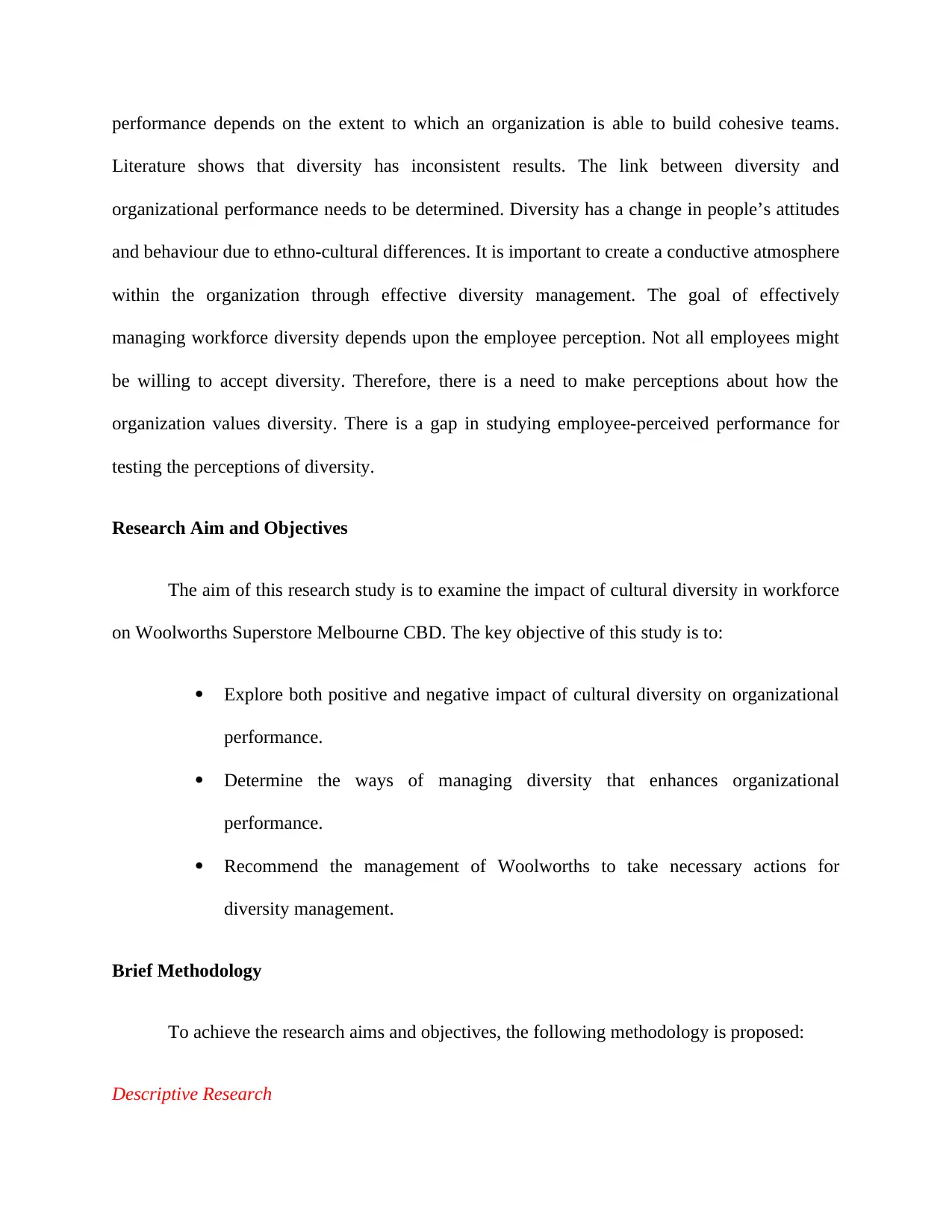
performance depends on the extent to which an organization is able to build cohesive teams.
Literature shows that diversity has inconsistent results. The link between diversity and
organizational performance needs to be determined. Diversity has a change in people’s attitudes
and behaviour due to ethno-cultural differences. It is important to create a conductive atmosphere
within the organization through effective diversity management. The goal of effectively
managing workforce diversity depends upon the employee perception. Not all employees might
be willing to accept diversity. Therefore, there is a need to make perceptions about how the
organization values diversity. There is a gap in studying employee-perceived performance for
testing the perceptions of diversity.
Research Aim and Objectives
The aim of this research study is to examine the impact of cultural diversity in workforce
on Woolworths Superstore Melbourne CBD. The key objective of this study is to:
Explore both positive and negative impact of cultural diversity on organizational
performance.
Determine the ways of managing diversity that enhances organizational
performance.
Recommend the management of Woolworths to take necessary actions for
diversity management.
Brief Methodology
To achieve the research aims and objectives, the following methodology is proposed:
Descriptive Research
Literature shows that diversity has inconsistent results. The link between diversity and
organizational performance needs to be determined. Diversity has a change in people’s attitudes
and behaviour due to ethno-cultural differences. It is important to create a conductive atmosphere
within the organization through effective diversity management. The goal of effectively
managing workforce diversity depends upon the employee perception. Not all employees might
be willing to accept diversity. Therefore, there is a need to make perceptions about how the
organization values diversity. There is a gap in studying employee-perceived performance for
testing the perceptions of diversity.
Research Aim and Objectives
The aim of this research study is to examine the impact of cultural diversity in workforce
on Woolworths Superstore Melbourne CBD. The key objective of this study is to:
Explore both positive and negative impact of cultural diversity on organizational
performance.
Determine the ways of managing diversity that enhances organizational
performance.
Recommend the management of Woolworths to take necessary actions for
diversity management.
Brief Methodology
To achieve the research aims and objectives, the following methodology is proposed:
Descriptive Research
Paraphrase This Document
Need a fresh take? Get an instant paraphrase of this document with our AI Paraphraser
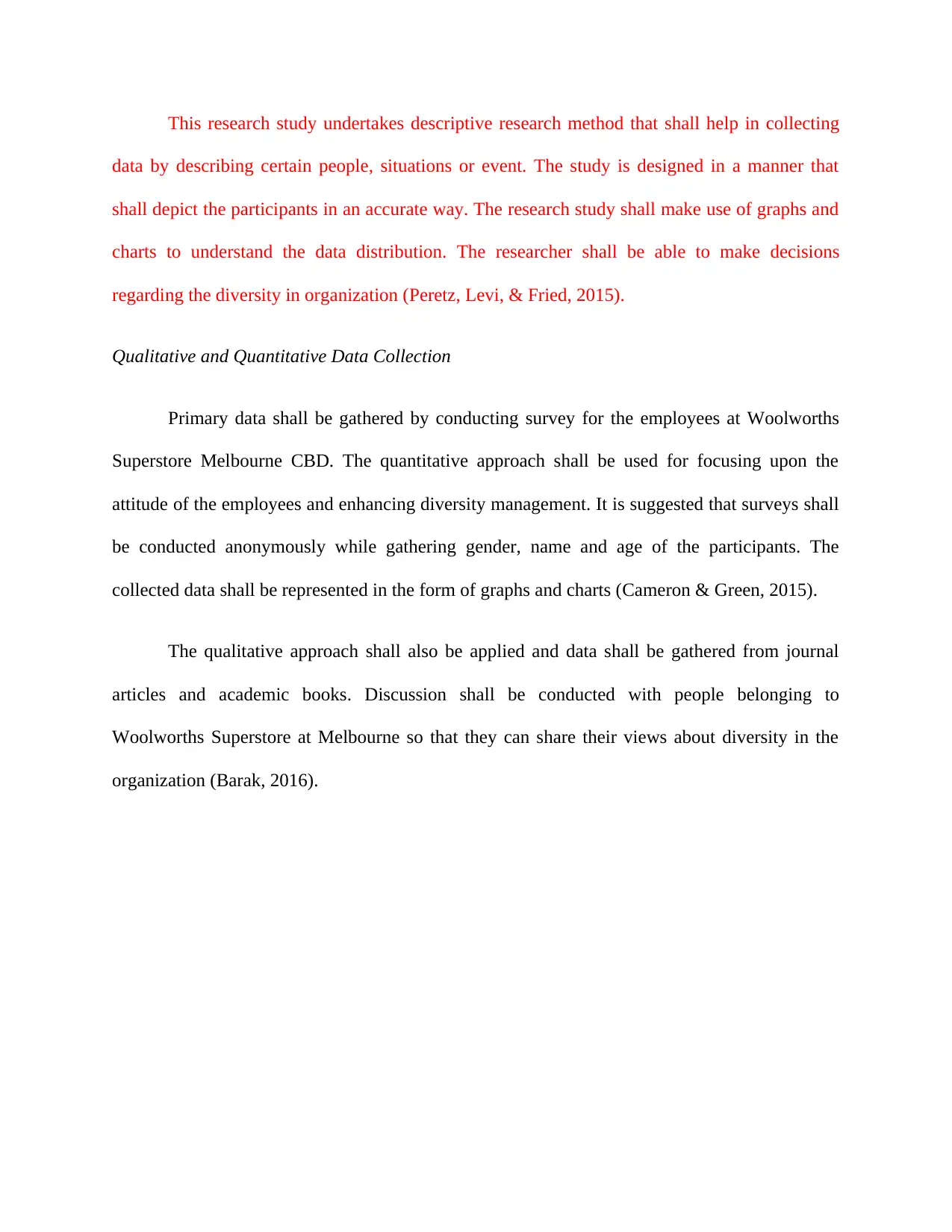
This research study undertakes descriptive research method that shall help in collecting
data by describing certain people, situations or event. The study is designed in a manner that
shall depict the participants in an accurate way. The research study shall make use of graphs and
charts to understand the data distribution. The researcher shall be able to make decisions
regarding the diversity in organization (Peretz, Levi, & Fried, 2015).
Qualitative and Quantitative Data Collection
Primary data shall be gathered by conducting survey for the employees at Woolworths
Superstore Melbourne CBD. The quantitative approach shall be used for focusing upon the
attitude of the employees and enhancing diversity management. It is suggested that surveys shall
be conducted anonymously while gathering gender, name and age of the participants. The
collected data shall be represented in the form of graphs and charts (Cameron & Green, 2015).
The qualitative approach shall also be applied and data shall be gathered from journal
articles and academic books. Discussion shall be conducted with people belonging to
Woolworths Superstore at Melbourne so that they can share their views about diversity in the
organization (Barak, 2016).
data by describing certain people, situations or event. The study is designed in a manner that
shall depict the participants in an accurate way. The research study shall make use of graphs and
charts to understand the data distribution. The researcher shall be able to make decisions
regarding the diversity in organization (Peretz, Levi, & Fried, 2015).
Qualitative and Quantitative Data Collection
Primary data shall be gathered by conducting survey for the employees at Woolworths
Superstore Melbourne CBD. The quantitative approach shall be used for focusing upon the
attitude of the employees and enhancing diversity management. It is suggested that surveys shall
be conducted anonymously while gathering gender, name and age of the participants. The
collected data shall be represented in the form of graphs and charts (Cameron & Green, 2015).
The qualitative approach shall also be applied and data shall be gathered from journal
articles and academic books. Discussion shall be conducted with people belonging to
Woolworths Superstore at Melbourne so that they can share their views about diversity in the
organization (Barak, 2016).
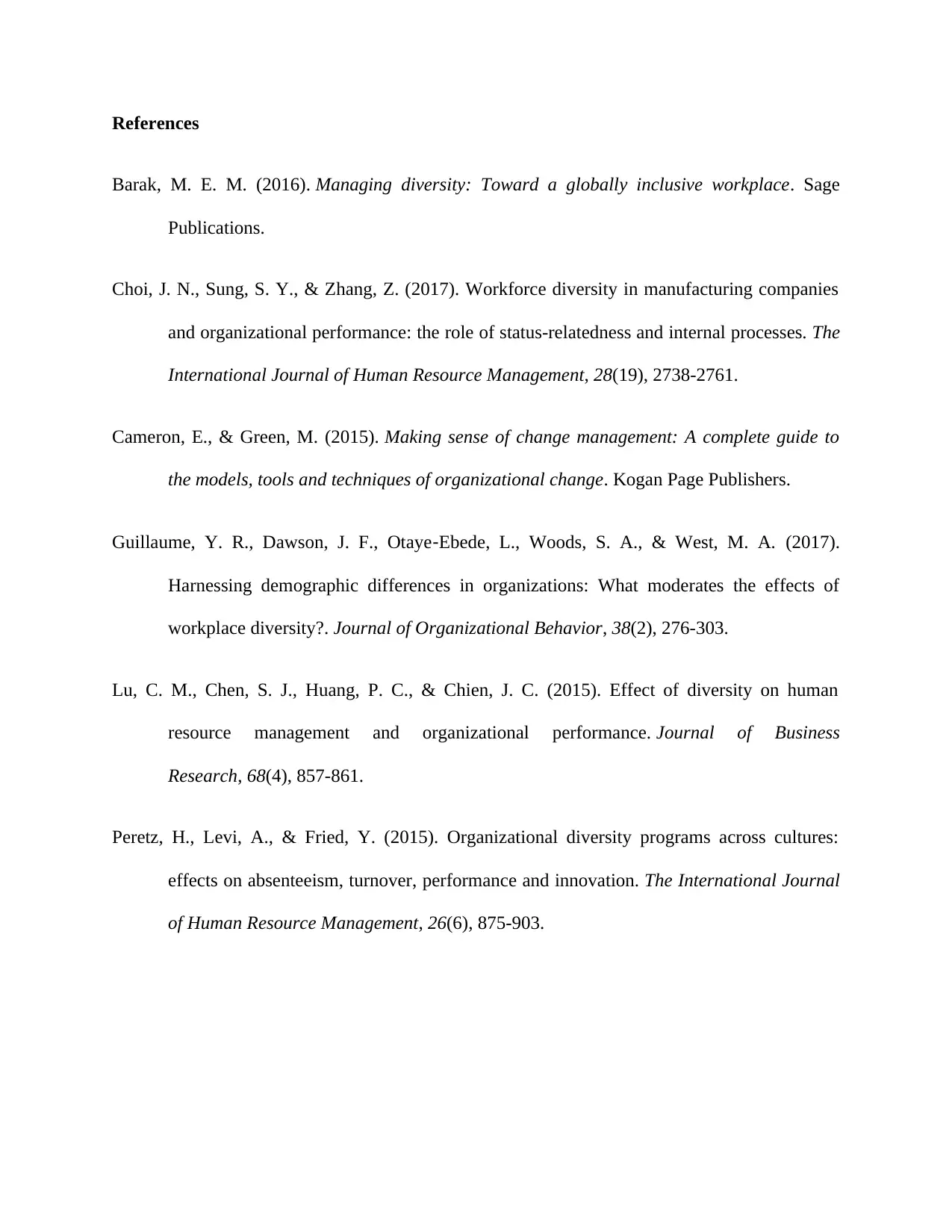
References
Barak, M. E. M. (2016). Managing diversity: Toward a globally inclusive workplace. Sage
Publications.
Choi, J. N., Sung, S. Y., & Zhang, Z. (2017). Workforce diversity in manufacturing companies
and organizational performance: the role of status-relatedness and internal processes. The
International Journal of Human Resource Management, 28(19), 2738-2761.
Cameron, E., & Green, M. (2015). Making sense of change management: A complete guide to
the models, tools and techniques of organizational change. Kogan Page Publishers.
Guillaume, Y. R., Dawson, J. F., Otaye‐Ebede, L., Woods, S. A., & West, M. A. (2017).
Harnessing demographic differences in organizations: What moderates the effects of
workplace diversity?. Journal of Organizational Behavior, 38(2), 276-303.
Lu, C. M., Chen, S. J., Huang, P. C., & Chien, J. C. (2015). Effect of diversity on human
resource management and organizational performance. Journal of Business
Research, 68(4), 857-861.
Peretz, H., Levi, A., & Fried, Y. (2015). Organizational diversity programs across cultures:
effects on absenteeism, turnover, performance and innovation. The International Journal
of Human Resource Management, 26(6), 875-903.
Barak, M. E. M. (2016). Managing diversity: Toward a globally inclusive workplace. Sage
Publications.
Choi, J. N., Sung, S. Y., & Zhang, Z. (2017). Workforce diversity in manufacturing companies
and organizational performance: the role of status-relatedness and internal processes. The
International Journal of Human Resource Management, 28(19), 2738-2761.
Cameron, E., & Green, M. (2015). Making sense of change management: A complete guide to
the models, tools and techniques of organizational change. Kogan Page Publishers.
Guillaume, Y. R., Dawson, J. F., Otaye‐Ebede, L., Woods, S. A., & West, M. A. (2017).
Harnessing demographic differences in organizations: What moderates the effects of
workplace diversity?. Journal of Organizational Behavior, 38(2), 276-303.
Lu, C. M., Chen, S. J., Huang, P. C., & Chien, J. C. (2015). Effect of diversity on human
resource management and organizational performance. Journal of Business
Research, 68(4), 857-861.
Peretz, H., Levi, A., & Fried, Y. (2015). Organizational diversity programs across cultures:
effects on absenteeism, turnover, performance and innovation. The International Journal
of Human Resource Management, 26(6), 875-903.
⊘ This is a preview!⊘
Do you want full access?
Subscribe today to unlock all pages.

Trusted by 1+ million students worldwide
1 out of 6
Related Documents
Your All-in-One AI-Powered Toolkit for Academic Success.
+13062052269
info@desklib.com
Available 24*7 on WhatsApp / Email
![[object Object]](/_next/static/media/star-bottom.7253800d.svg)
Unlock your academic potential
Copyright © 2020–2025 A2Z Services. All Rights Reserved. Developed and managed by ZUCOL.





